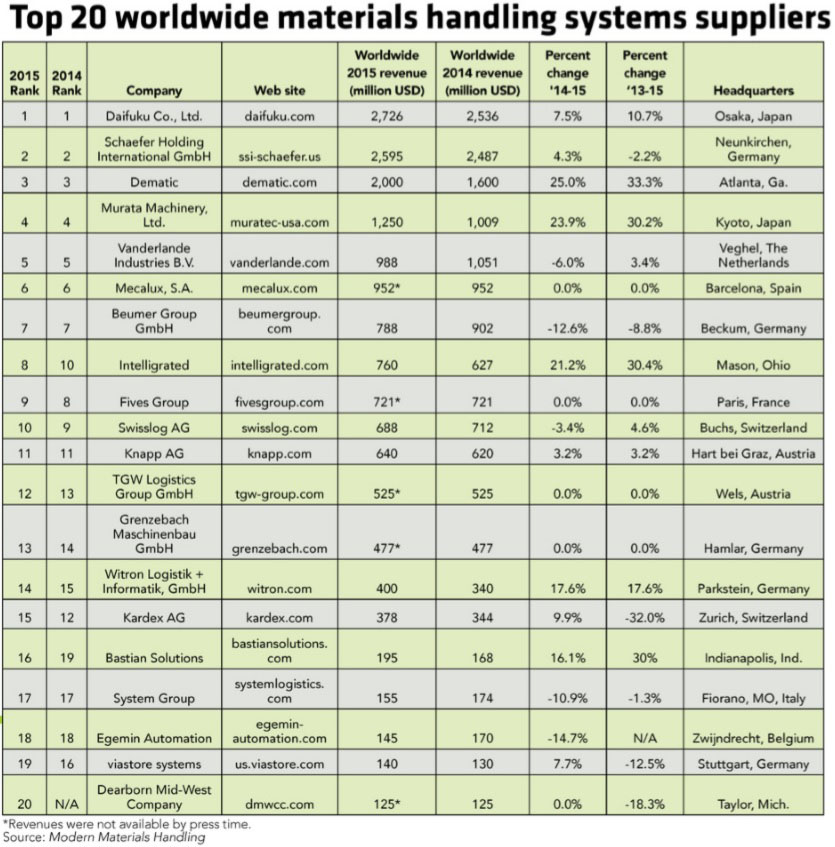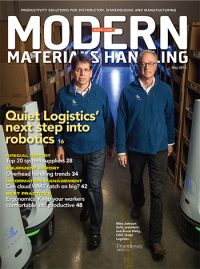Top 20 systems suppliers, 2016
A robust industry continues strong growth with impressive performances among the biggest players.
Latest Material Handling News
Registration open for Pack Expo International 2024 Walmart chooses Swisslog AS/RS and software for third milk processing facility NetLogistik partners with Vuzix subsidiary Moviynt to offer mobility solutions for warehouses Lucas Watson appointed CSO for Körber’s Parcel Logistics business in North America Hyster recognizes Dealers of Distinction for 2023 More NewsDespite currency conversion woes, the pace of growth among the largest systems suppliers in the materials handling industry remains strong, driven by increased interest in automation and aftermarket support.
Those are two important takeaways from Modern’s 19th-annual “Top 20 Systems Suppliers” list, which shows nearly universal revenue growth in 2015 among the top players, including some double-digit performances. The numbers also reveal that once again, Daifuku and Schaefer Systems International (SSI) lead the industry, with both reporting 2015 revenue well above $2.5 billion. Read last year’s list.
Even after accounting for currency conversions that chipped away at revenue gains reported by foreign companies, the combined value of the Top 20 increased by 6%, including 10% growth by the top five.
While some industry experts were predicting a softer market, 2015’s reported growth comes as no surprise to Norm Saenz, a managing director of St. Onge Co. “There is a lot happening in the supply chain that is driving the need for more automation, like the continued growth in e-commerce and the emergence of omni-channel fulfillment,” Saenz says. “I’m not surprised to see the overall 2015 revenue numbers increased over 2014, and I did notice that a few of the manufacturers with strong North American businesses (Intelligrated, Dematic and Bastian) had some of the top revenue gains. Given the current demands on operations to handle more products and volumes this growth is only going to increase into 2016.”
The view from the top
After Daifuku claimed the No. 1 spot last year, edging out its longtime rival Schaefer Systems International (SSI) by less than $50 million, it continued atop the leader’s list after posting a 7.5% gain to $2.73 billion. A Daifuku representative reports that sales of materials handling systems for flat panel displays and semiconductors in Asia increased greatly, as did sales of retail solutions, including e-commerce. The company also cited steady growth in maintenance and aftermarket services—a theme repeated by Dematic, Vanderlande, Intelligrated and Knapp.
SSI held steady in second place, posting nearly $2.6 billion, an 11% increase in Euros over 2014, according to president Arnold Heuzen. As a result of the devaluation of the Euro versus the dollar, our list indicates growth of 4.3%. “Schaefer continues to experience strong demand for its systems solutions in the areas of intralogistics, retail distribution and e-commerce fulfillment,” Heuzen says.
Dematic again secured third place, but reported the largest growth rate on the list, jumping 25% from $1.6 billion to an even $2 billion. In December 2015, Dematic acquired Reddwerks Corp., a provider of warehouse execution software (WES). The company also cited a broadening market for solutions targeting small-to-mid-sized businesses that are aiming to enhance their capabilities.

“The global supply chain needs to be flexible, responsive and agile and empowered to deliver goods to consumers on demand,” said Dematic president and CEO Ulf Henriksson following the Reddwerks acquisition. “Retailers and manufacturers need to be positioned to respond to this dynamic demand. The only way to effectively achieve responsive order fulfillment is through an automated supply chain, powered by comprehensive real-time software.”
In fourth place is Murata Machinery, which reported a 24% growth rate to close 2015 with $1.25 billion in revenues—one of just three companies to post growth in excess of 20%, and coming on top of more than 14% growth in 2014. Much of that growth was the result of Murata’s 2014 acquisition of Finnish automated materials handling supplier Cimcorp, which contributed more than $200 million to that year’s revenues.
Dipping just below the $1 billion mark, Vanderlande Industries held the fifth place spot on the list. In late 2014, Vanderlande acquired Smatec GmbH, a warehouse automation specialist that provides solutions such as bomb bay and pocket sorters.
CEO Govert Hamers notes that Vanderlande had a breakthrough year in each of its focus areas: food retail, fashion, parts and components, and e-commerce, along with an uptick in the number of service contracts, which now constitutes 20% of revenue. “Companies are moving up from manual and automated-assisted manual systems toward full automation,” Hamers says. “Cost reduction is a major driver, as is the consolidation of distribution networks—customers want fewer, larger distribution centers. Automation delivers efficiency and predictable, lower operational costs.”
The rest of the pack
Given fiscal year ends, several companies were unable to report revenues by press time. In these cases, we’ve held previously reported revenues to preserve each company’s relative position on the list. One of those was sixth-place finisher Mecalux.
Seventh-place Beumer held its ranking with its second consecutive year of 4.4% growth—at least in Euros, which belies an apparent drop in revenues following currency conversion.
Intelligrated posted 2015 revenues of $760 million, growing by $133 million, or 21%, and jumping two spots to 8th place. The company attributes its banner year to continued interest in solutions that address Internet retailing and the state of the logistics workforce. “The volume and complexity of e-commerce and omni-channel retail continue to drive our customers to find more efficient ways to manage and move inventory,” says Chris Cole, Intelligrated’s co-founder and CEO. “This requires our industry to deliver reliable results and return on investment, with the flexibility to accommodate evolving business requirements.”
Ninth-place finisher Fives Group was unable to provide 2015 revenues by press time, so the company’s previous total of $721 million has been carried over.
At No. 10, Swisslog held steady at just shy of $700 million. After becoming a member of the KUKA Group in early 2015, Swisslog continues to be managed as a separate unit within the group. In April 2015, Swisslog acquired Forte Industries, a Mason, Ohio-headquartered system integrator for warehouse automation. According to Bill Leber, director of business development and marketing for Swisslog, the acquisition is intended to strengthen the company’s strategy by adding a complimentary spectrum of products and services while increasing the range of market coverage, especially in the e-commerce and pharmaceutical segments.
Growth across the board
In our previous list, the biggest players got bigger while numbers 11 through 20 collectively grew revenue by less than 1%. In 2015, the bottom 10 achieved 3.5% growth while the top 10—which account for 81% of the list’s total value—grew 7%.
In 11th place, Knapp grew to $640 million amid a dynamic year, according to Kevin Reader, Knapp’s director of business development and marketing. “There have been lots of changes,” he says. “We started new divisions focused on broad-based channels, and our research and development initiatives are bearing fruit.”
In 12th and 13th, TGW and Grenzebach were again unable to report revenues by press time.
In 14th place, Witron tallied $400 million, an 18% improvement. A representative cited another strong year with new projects awarded in Europe, North America and Asia.
In 15th place, Kardex reported revenues of $378 million last year, up from 2014’s $344 million—and that followed a restructuring year. “Due to our divestiture with Kardex Stow in 2013, our latest figures do not compare to years past,” says Tom Coyne, president, North America. “However, we experienced a 10% growth in 2015 over 2014.”
After its first appearance on the list last year, Bastian Solutions has climbed to 16th with $195 million in 2015 revenue, showing 16% growth. In the first quarter of 2015, it acquired Forte Engineering, a Chicago-based specialist in warehouse execution systems, to grow its wine and spirits industry segment.
“Bastian Solutions entered three new U.S. markets in 2015 including Memphis, Dallas and Chicago and experienced incremental growth in each of these markets,” says Aaron Jones, president of Bastian Solutions. “In early 2015, we also expanded our presence within Mexico, creating new offices which proved to be very beneficial. In South America, our team in Sao Paulo, Brazil penetrated business outside of the country in Chile, Argentina, and Ecuador. Overall, it was a very positive year for our company, domestically and internationally.”
In 17th place, Italy-based System Group (System Logistics, Modula) reported $155 million in revenues.
In 18th place, Egemin Automation’s revenues ($145 million) reflect a few developments within the business. Egemin’s handling automation division was acquired by KION Group in mid-2015. At that time, several disinvestments of subdivisions contributed to the decline in revenues, according to Michaël Coryn, marketing communications manager for Egemin. The 2015 figures also now include the combined revenues of Egemin and Retrotech, which Egemin Group acquired from Savoye in early 2016.
After revising its 2014 revenues to $130 million, 19th-place viastore reported 8% growth to $140 million.
Elettric 80 ($118 million) narrowly missed the list this year, and Dearborn Midwest Conveyor Co. claimed the final slot with $125 million. However, given Dearborn’s late 2015 acquisition of W&H Systems—which will be integrated into the company’s material handling systems division and rebranded DMW&H—Dearborn’s 2016 revenues could change their ranking yet again. In addition, Dearborn’s bulk handling group was acquired in late 2015 by Bedeschi S.P.A. of Italy, and was rebranded as Bedeschi Mid-West Conveyor LLC (BMWC).
And what about the year to come? The industry outlook for 2016 is good, according to a survey of 900 materials handling professionals conducted by MHI and Deloitte and who anticipate strong investment in solutions to maintain, update and improve daily operations.
Survey participants represent a combined $8.8 billion in tactical investments over the next two years. MHI CEO George Prest wasn’t surprised, and says more manufacturing and supply chain firms are increasing their financial commitment to innovation. “New technology investments over $1 million have increased from 42% a year ago to 52% today,” he says. “Nearly 66% of respondents expect to increase their tactical investment budgets over the next two years—and 20% call that increase ‘significant.’ The investment increase is keeping pace with that dedicated to emerging technologies.”
Making the list
To qualify for Modern’s Top 20 list, companies must be suppliers of materials handling systems, not just equipment providers. In addition to manufacturing at least two major handling system components, a company must also employ full-time staff that designs, installs and integrates materials handling systems.
These systems include at least two of the following: transportation devices, storage and staging equipment, picking units, sortation systems, information management systems, data capture technologies and other types of handling equipment.
To be considered worldwide suppliers, companies must have a presence in North America and must also be able to report materials handling revenues to Modern. (Lockheed Martin, for example, is a systems supplier with a North American presence, but isn’t included in our Top 20 list because they can’t single out the revenue that comes from materials handling contracts.)

Article Topics
Latest in Materials Handling
Registration open for Pack Expo International 2024 Walmart chooses Swisslog AS/RS and software for third milk processing facility NetLogistik partners with Vuzix subsidiary Moviynt to offer mobility solutions for warehouses Materials Handling Robotics: The new world of heterogeneous robotic integration BSLBATT is looking for new distributors and resellers worldwide Lucas Watson appointed CSO for Körber’s Parcel Logistics business in North America Hyster recognizes Dealers of Distinction for 2023 More Materials HandlingAbout the Author
Subscribe to Materials Handling Magazine

Find out what the world's most innovative companies are doing to improve productivity in their plants and distribution centers.
Start your FREE subscription today.
April 2024 Modern Materials Handling

Latest Resources











